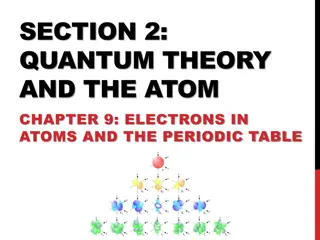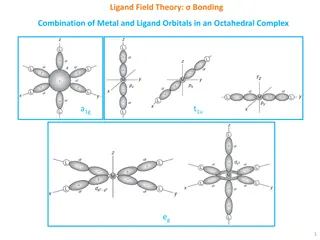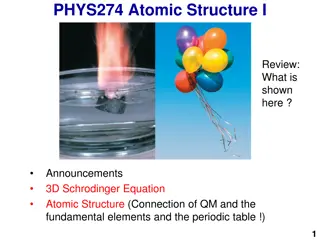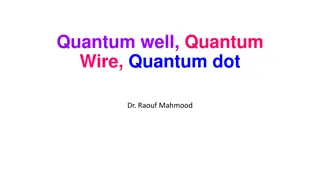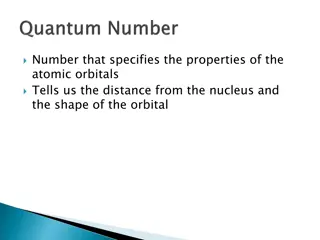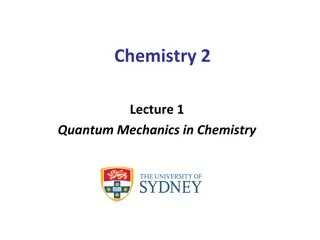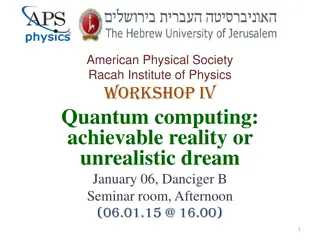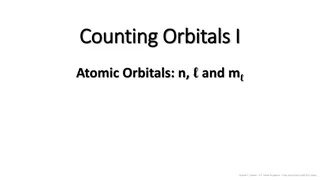Understanding Quantum Chemistry and Electron Orbitals
Quantum chemistry plays a key role in determining chemical bonds, phase stabilities, and mineral physics through the study of electron orbitals, quantum numbers, and energy levels. This involves concepts such as the Schrödinger equation, quantum quantities, and the uncertainty principle. The arrangement of electrons within orbitals is governed by quantum numbers, which define their spatial distribution and spin. The anomalies in 3d and 4d elements, as well as the properties of superheavy elements, further highlight the intricate relationships between atomic structure and chemical behavior.
Download Presentation

Please find below an Image/Link to download the presentation.
The content on the website is provided AS IS for your information and personal use only. It may not be sold, licensed, or shared on other websites without obtaining consent from the author. Download presentation by click this link. If you encounter any issues during the download, it is possible that the publisher has removed the file from their server.
E N D
Presentation Transcript
Quantum chemistry determines chemical bonds and therefore: - relative phase stabilities - mineral physics (e.g. thermo-elasticity, electric and thermal conductivity, thermal radiativity) The term quantum: quantities, i.e. discrete amounts, corresponding to electron orbitals h x m h, Planck const.; x, position m, momentum Schr dinger equation, equivalent to Newton's 2. law of classical mechanics: F = m*a State of electrons: - distribution and electron density Heisenberg's uncertainty principle - used in first principles atomistic simulation by density functional theory, DFT General, time-independant expression of the Schr dinger equation: = H H: Hamiltonian operator acting on the wave function, E: energy of the state 4 partial functions Wave function: (r ) = R(r) ( ) ( ) s radius (distance) spin (direction) rotation-2 rotation-1 Spherical coordinates: r, , Cartesian coordinates: x, y, z The quantum numbers (QN) correspond to the partial functions Principal QN, n ~ R Angular momentum QN, l ~ Magnetic QN, mL~ Spin QN, mS~ s
Quantum numbers Principal QN: n = 1, 2, - - -, 7 (corresponding to the K, L, M, N, O, P and Q shells, energy levels) Angular momentum QN: l For a given n, l can be: 0, - - -,n 1 i.e. for n=3, l is 0, 1, 2 Magnetic QN: mL For a given l, mLcan be: l, (l 1), - - -, 0, - - -, l , l i.e. for l=2, mL is 2, 1, 0, 1, 2 Spin QN: mS For a every mL, mscan be: 1/2, +1/2 (each individual orbital can have two electrons with opposite spin)
Quantum numbers and electron orbitals one s-orbital three p-orbitals five d-orbitals seven f-orb 2 s-electrons 2 el. Domains of high electron probability 2 el. 2 el. Note: 4s is lower than 3d, 5s is lower than 4d, etc. 2 el. 2 el. 2 el. 2 el. 2 el.
3d and 4d anomalies: Scerri (2019, Nature) Lanthanide contraction Decreasing ionic radii (trivalent) from La to Lu. Why? Poor nuclear shielding by 4f-orbital and the poorly filled O-shell 6s-electons are pulled inwards.
95 Am: Americum 96 Cm: Curium 97 Bk: Berkelium 98 Cf: Californium 99 Es: Einsteinuim 100 Fm: Fermium 101 Md: Mendelevium 102 No: Nobelium 103 Lr: Lawrencium 104 Rf: Rutherfordium 105 Db: Dubnium 106 Sg: Seaborgium 107 Bh: Bohrium 108 Hs: Hassium 109 Mt: Meitnerium 110 Ds: Darmstadtium 111 Rg: Roentgenium 112 Cn: Copernicum 113 Nh: Nihonium 114 Fl: Flerovium 115 Mc: Moscovium 116 Lv: Livermorium 117 Ts: Tennessine 118 Og: Oganesson Superheavy elements: e.g. Ball (2019, Nature) Noble gases, He to Rn: Full s+p orbitals of K-P shells K L M N O P 115 Mc 116 Lv 117 Ts 118 Og Nh Q Fl Cn Ds Rg 7p 111 111
Electronic spin state transition metal ions, esp. Fe 3d 4s 3d-transition metals: [Ar] 3dX4s2 Sc: 3d14s2 Ti: 3d24s2 V: 3d34s2 Cr: 3d54s1 Mn: 3d54s2 Fe: 3d64s2 Co: 3d74s2 Ni: 3d84s2 Cu: 3d104s1 Zn: 3d104s2 Fe: 3d64s2 Fe-ions: Fe2+: 3d6 Fe3+: 3d5 Maximum magnetic moment Very high pressures will ultimately favour pairing of electrons into the lowest energy orbitals Energy cost (repulsion) of pairing electrons degenerate orbitals in isolated elements i.e. maximum number of unpaired electrons (all orbitals have equal probability of being filled)
Crystal field theory - describes electrostatic forces on cations from surrounding anions (ligands) - ligands are regarded as point charges electromagnetic crystal field - electro-density distribution of the cation influences the stability of cation-anion configuration eg-orbitals along axes t2g-orbitals between axes Octahedral coordination polyhedron eg-orbitals (along axes): stronger electrostatic repulsion higher energy Energy t2g-orbitals (between axes): less electrostatic repulsion lower energy CF splitting
Oxygen electronic configuration: even, spherical electron density 2p 2pz 1s 2s 2py 2px O: 1s22s2 2p4 O2 : 1s22s2 2p6 Tetrahedral coordination polyhedron t2g-orbitals: strong electrostatic repulsion high energy Energy CF splitting eg-orbitals: less electrostatic repulsion low energy
Isolated cation (e.g in outer space) Octahedral crystal field splitting Energy eg egbandwidth Cation in octahedral crystal field CFS t2g t2g bandwidth CFSE Cation in ideal / isotropic anion polyhedron Shulenburger et al. (2010, J.Phys.) EF: Fermi energy level DOS: Density of states 1/(eV*spin)
eg-orbitals along axes t2g-orbitals between axes t2g: between axes, low repusion, low energy eg: along axes, low repusion, low energy Energy Octahedral CFSE
Fe2+spin state in ferropericlase Wide stability field of mixed spin state (equal proportions of FeHSand FeLS) minimises crystal lattice strain) Ionic radii, octahedral coordination (Shannon & Prewitt 1969, 1970, Acta. Cryst. B) Mg2+: 0.72 Fe2+HS: 0.78 Fe2+LS: 0.61 O2 : 1.40 F-2007: Fei et al., 2007, GRL K-2010: Komabayashi et al., 2010, EPSL HS-2015: Holmstr m & Stixrude, 2015, PRL
3D-ferropericlase structure (Mg,Fe)O Mg,Fe O Creative Commons Attribution Share Alike 4.0 International
Fe2+spin state in ferropericlase Effects on elastic moduli and wave-speeds Valencia-Cardona et al. 2017, GRL
Fe2+spin state in ferropericlase Effects on elastic moduli Kennett 2021, EPSL fp: Mg87.5Fe12.5O100 Ab initio, along BS-81 adiabat, Wu et al. 2013, PRL G: Shear modulus K: bulk modulus p: pressure Calculated without spin crossover effect Elevated K in low-spin state
Fe2+spin state in ferropericlase Effects on elastic moduli and wave-speeds Kennett 2021, EPSL Mg81.25Fe18.75O Ab initio, 2000 K, Wu et al. 2013, PRL Marquardt et al. 2009, EPSL 0.40
Fe2+spin state in ferropericlase Effects on elastic moduli and wave-speeds Kennett 2021, EPSL normal modes high G, low K sensitivity Concave upwards: body waves Convex upwards:
Spatial resolution by seismic tomography vote map method (Shephard et al. 2021, Nat. Comm) One particular tomography model at one specific depth: Extracting fast (e.g. >+1 ) and slow (e.g. < 1 ) areas Combining 4 models at the same depth Combining models at numerous depths through the lower mantle
Loss of strong Vp anomalies ... D TBL , full score No indication of a spin signal in the ambient (average velocity) mantle - but would we be able to detect it or confirm a lack of signal? Possibly not - a very challenging task - would an absent signal, is confirmed, indicate fp-free, refractory and highly viscous bm-dominated material (BEAMS)? - where is the ambient (average velocity) in the lower mantle? Yes, very likely Let s look at a map and a cross-section
- BEAMS are positioned to avoid interference with the slabs mapped by van der Meer et al. (2010, NG, 2019, Tectonoph) - Viscous and refractory bridgmanitic material is strongly indicated from a petrological point of view early MO-crystallisation during core-MO and core-BMO chemical exchange (CEED Ann. Report 2020, SAB-seminar, 2021). (B)MO: (basal) magma ocean - Early refractory domains are likely to be convectively aggregated into BEAMS (Manga 1996a,b, GRL; Becker et al. 1999, EPSL; Ballmer et al. 2017, NG)
- MgSiO3-dominated bm is neutrally buoyant in the mid-LM - Very refractory in the LM, but less so as an opx-component in the upper mantle
Bridgmanite (bm) and post-bridgmanite (pbm): ABO3-compounds Site occupacy A: Mg2+Fe2+ B: Si4+ Additional trivalent cations, mostly: Fe3+A AlB System MSA-Fe3+ Trivalent substitution vectors FeAlO3 FeSiO3
Mohn & Trnnes (2016, EPSL) Bridgmanite (bm) crystallographic site occupancy and spin-state of Fe Phase relations of bm in peridotitic (including strongly depleted peridotites)and basaltic lithologies Only four components are relevant (present) in the deeper parts of the lower mantle (>40 GPa): MS, FS, FA, AA, i.e. MgSiO3 FeSiO3, FeAlO3, Al2O3 Uppermost part (<40 GPa) of the lower mantle: The O-vacant component MA, MgAlO2.5may also be present. The bm component FF, Fe2O3, which is not present in the common lithologies of the Earth's mantle, but possibly in subducted BIFs (banded iron formations), if they exist, has equal amounts of Fe3+A-HSand Fe3+B-LSat pressures exceeding 40-50 GPa. Fe site occupancy and spin state FS-component Fe2+A-HSis the stable configuration. Nearly ideal MS-FS mixing and no metastability or kinetcs problems Ab initio study of A- and B-site occupancy and Fe spin state in bm (Mohn & Tr nnes, 2016, EPSL) Methods - summary - DFT and Boltzmann statistics of numerous configurations, VASP software - Thermodynamic properties from configurational Boltzmann averaging at 3000 K i Yiexp( Gi/ kBT) exp( Gi/ kBT) i FA-component Fe3+A-HSis the stable configuration based on ab initio theory and experiments, starting from pre-synthesised polycrystalline or single crystal bm at about 24 GPa. Property Y = Gibbs free energy: Gi= Hi+ Ei-TSifor configuration i. Hi: static enthalpy, Si: vibr. entropy (quasiharmonic lattice dyn.), Ei: zero point motion Experiments (LH-DAC) synthesising bm directly from amorphous starting materials (glass or gel) at > 40 GPa may trap, metastably, some Fe3+B-LS, compensated by a corresponding amount of AlA. - Gi and spin-polarisations of Fe were calculated by alternative functionals, especially GGA and GGA +U (U: 5eV for FA, 3eV for FS) - Elastic constants are calculated directly from the force constants. - Simulation box: 80 atoms = 16 fmu, energy cut-off: 700 eV, k-mesh grid:2*2*2
Site occupancy and spin state, FA-component in bm and pbm at lowermost mantle condition - Contentious issues, but agreement that Fe3+Ais HS and Fe3+Bis LS (e.g. on the MS-Fe2O3join) - Some exp. on the MS-FA join indicate metastable trapping of theAlA-Fe3+B-LSconfig. (e.g Hsu et al. 2012, EPSL) Enthalpy-volume relations for configurations in bridgmanite (Mohn & Tr nnes, 2016, EPSL) HS-Fe3+Ais energetically favourable compared to LS-Fe3+B, especially with the GGA+U and HSE06 functionals (conventional GGA: hampered by self-interaction errors). BUT the volume of HS-Fe3+Ais rather high.
Site population and spin state, Fe3+in MS-FA bridgmanite 2000-5000 K 118-145 GPa total pressure 6.25 and 12.5 mol% FA GGA+U: 100-96% Fe3+A-HS 0-4% Fe3+B-LS GGA: 80-70% Fe3+A-HS 20-30% Fe3+B-LS Summary, Fe spin state and site occupancy MS-FA join: the configuration Fe3+A-HSAlBis energetically favourable in both bm and pbm MS-FS join: Fe2+A-HSis also energetically favourable in both bm and pbm
But is the volume an obstacle? Cation-oxygen bond lengths, MS-FA-join regular octahedral B site irregularA site IrregularA site No specific coord. numb. Mg-O bond lengths are "grouped" with a 4-2-2-2 division: 4 at 1.85-1.92, 2 at 2.08-2.09, 2 at 2.54-2.55 and 2 at 2.65-2.66 , resp. - Considerable charge transfer and covalency of flexible Fe-O bonds - Large HS-Fe fits well in the irregular A site Deviations (%) from fully ionic character (GGA +U) Mg2+A: 14 Si4+B: 19 Fe3+A-HS: 38 Al3+B: 18 OFeA-HS: 18 Al3+A: 17 Fe3+B-LS: 49 Bader radius ( ) Mg2+A: 0.77 Si4+B: 0.65 Fe3+A-HS: 0.92 Al3+B: 0.68 OFeA-HS: 1.03 521 3 Al3+A: 0.72 Fe3+B-LS: 0.90 V80-atom cell(FA6.25%) OFeB-LS: 18 OFeB-LS: 1.03 519 3




